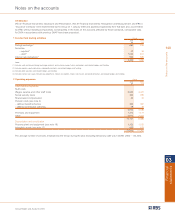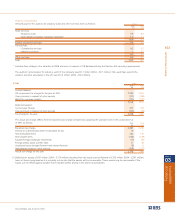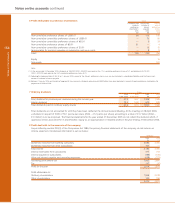RBS 2005 Annual Report Download - page 146
Download and view the complete annual report
Please find page 146 of the 2005 RBS annual report below. You can navigate through the pages in the report by either clicking on the pages listed below, or by using the keyword search tool below to find specific information within the annual report.
144
Accounting policies
incidence, timing and amount of claims and any specific
factors such as adverse weather conditions. In order to calculate
the total provision required, the historical development of
claims is analysed using statistical methodology to extrapolate,
within acceptable probability parameters, the value of
outstanding claims at the balance sheet date. Also included in
the estimation of outstanding claims are other assumptions
such as the inflationary factor used for bodily injury claims
which is based on historical trends and, therefore, allows for
some increase due to changes in common law and statute.
Costs for both direct and indirect claims handling expenses are
also included. Outward reinsurance recoveries are accounted for
in the same accounting period as the direct claims to which they
relate. The outstanding claims provision is based on information
available to management and the eventual outcome may vary
from the original assessment. Actual claims experience may differ
from the historical pattern on which the estimate is based and
the cost of settling individual claims may exceed that assumed.
Goodwill
The Group capitalises goodwill arising on the acquisition of
businesses, as disclosed in the Accounting policies. The
carrying value of goodwill as at 31 December 2005 was
£18,823 million (2004 – £18,032 million).
Goodwill is the excess of the cost of an acquisition over the fair
value of its net assets. The determination of the fair value of
assets and liabilities of businesses acquired requires the exercise
of management judgement; for example those financial assets
and liabilities for which there are no quoted prices, and those
non-financial assets where valuations reflect estimates of
market conditions such as property. Different fair values would
result in changes to the goodwill arising and to the post-acquisition
performance of the acquisition. Goodwill is not amortised but
is tested for impairment annually or more frequently if events or
changes in circumstances indicate that it might be impaired.
For the purposes of impairment testing goodwill acquired in a
business combination is allocated to each of the Group’s cash-
generating units or groups of cash-generating units expected to
benefit from the combination. Goodwill impairment testing
involves the comparison of the carrying value of a cash-
generating unit or group of cash generating units with its
recoverable amount. The recoverable amount is the higher of the
unit's fair value and its value in use. Value in use is the present
value of expected future cash flows from the cash-generating
unit or group of cash-generating units. Fair value is the amount
obtainable for the sale of the cash-generating unit in an arm’s
length transaction between knowledgeable, willing parties.
Impairment testing inherently involves a number of judgmental
areas: the preparation of cash flow forecasts for periods that
are beyond the normal requirements of management reporting;
the assessment of the discount rate appropriate to the
business; estimation of the fair value of cash-generating units;
and the valuation of the separable assets of each business
whose goodwill is being reviewed.
Accounting developments
International Financial Reporting Standards
The International Accounting Standards Board (“IASB”) issued
IFRS 7 ‘Financial Instruments: Disclosures’ in August 2005.
The standard replaces IAS 30 ‘Disclosures in the Financial
Statements of Banks and Similar Financial Institutions’ and the
disclosure provisions in IAS 32 ‘Financial Instruments: Disclosure
and Presentation’. IFRS 7 requires disclosure of the significance
of financial instruments for an entity’s financial position and
performance and of qualitative and quantitative information
about exposure to risks arising from financial instruments. The
standard is effective for annual periods beginning on or after 1
January 2007. Earlier application is encouraged.
At the same time the IASB issued an amendment ‘Capital
Disclosures’ to IAS 1 ‘Presentation of Financial Statements’. It
requires disclosures about an entity's capital and the way it is
managed. This amendment is also effective for annual periods
beginning on or after 1 January 2007. Earlier application is
encouraged.
The IASB has also issued three amendments to IAS 39
‘Financial Instruments: Recognition and Measurement’. The
first, ‘Cash Flow Hedge Accounting of Forecast Intragroup
Transactions’, published in April 2005, amends IAS 39 to
permit the foreign currency risk of a highly probable forecast
intragroup transaction to qualify as a hedged item in
consolidated financial statements. The amendment is effective
for annual periods beginning on or after 1 January 2006.
The second, ‘The Fair Value Option’, published in June 2005,
places conditions on the option in IAS 39 to designate on initial
recognition a financial asset or financial liability as at fair value
through profit or loss. The amendment is effective for annual
periods beginning on or after 1 January 2006. Earlier application
is encouraged. The Group has adopted this amendment from
1 January 2005 (see accounting policies on page 136).
The third, ‘Financial Guarantee Contracts’, published in August
2005, amends IAS 39 and IFRS 4 ‘Insurance Contracts’. The
amendments define a financial guarantee contract. They
require such contracts to be recorded initially at fair value
and subsequently at higher of the provision determined in
accordance with IAS 37 ‘Provisions, Contingent Liabilities
and Contingent Assets’ and the amount initially recognised
less amortisation. The amendments are effective for annual
periods beginning on or after 1 January 2006.
In December 2005, the IASB issued amendments to IAS 21
‘The Effects of Changes in Foreign Exchange Rates’ to clarify
that a monetary item can form part of the net investment in
overseas operations regardless of the currency in which it is
denominated and that the net investment in a foreign operation
can include a loan from a fellow subsidiary. The amendments
are effective immediately but have not been endorsed by the EU.
The Group is reviewing IFRS 7 and the amendments to IAS 1
and IAS 21 and those to IAS 39 that it has not implemented,
to determine their effect on its financial reporting.
US GAAP
For a discussion of recent developments in US GAAP relevant
to the Group, see Note 46 on the accounts.
Accounting policies continued
























